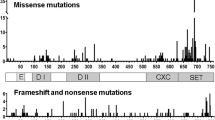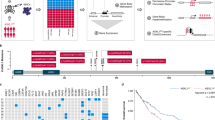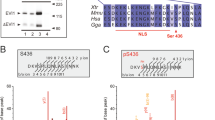Abstract
Polycomb repressive complex 2 (PRC2) is involved in trimethylation of histone H3 lysine 27 (H3K27), chromatin condensation and transcriptional repression. The silencing function of PRC2 complex is mostly attributed to its intrinsic activity for methylating H3K27. Unlike in B-cell lymphomas, enhancer of zeste homolog 2 (EZH2) mutations in myeloid malignancies are inactivating/hypomorphic. When we assessed the mutational status in myeloid malignancies (N=469 cases examined), we found EZH2 and EED/SUZ12 mutations in 8% and 3.3% of cases, respectively. In addition to mutant cases, reduced EZH2 expression was also found in 78% cases with hemizygous deletion (−7/del7q cases involving EZH2 locus) and 41% of cases with diploid chromosome 7, most interestingly cases with spliceosomal mutations (U2AF1/SRSF2 mutations; 63% of cases). EZH2 mutations were characterized by decreased H3K27 trimethylation and increased chromatin relaxation at specific gene loci accompanied by higher transcriptional activity. One of the major downstream target is HOX gene family, involved in the regulation of stem cell self-renewal. HOXA9 was found to be overexpressed in cases with decreased EZH2 expression either by EZH2/spliceosomal mutations or because of −7/del7q. In summary, our results suggest that loss of gene repression through a variety of mutations resulting in reduced H3K27 trimethylation may contribute to leukemogenesis.
This is a preview of subscription content, access via your institution
Access options
Subscribe to this journal
Receive 12 print issues and online access
$259.00 per year
only $21.58 per issue
Buy this article
- Purchase on Springer Link
- Instant access to full article PDF
Prices may be subject to local taxes which are calculated during checkout






Similar content being viewed by others
References
Greenberg P, Cox C, LeBeau MM, Fenaux P, Morel P, Sanz G et al. International scoring system for evaluating prognosis in myelodysplastic syndromes. Blood 1997; 89: 2079–2088.
Slovak ML, Kopecky KJ, Cassileth PA, Harrington DH, Theil KS, Mohamed A et al. Karyotypic analysis predicts outcome of preremission and postremission therapy in adult acute myeloid leukemia: a Southwest Oncology Group/Eastern Cooperative Oncology Group Study. Blood 2000; 96: 4075–4083.
Grimwade D, Hills RK, Moorman AV, Walker H, Chatters S, Goldstone AH et al. Refinement of cytogenetic classification in acute myeloid leukemia: determination of prognostic significance of rare recurring chromosomal abnormalities among 5876 younger adult patients treated in the United Kingdom Medical Research Council trials. Blood 2010; 116: 354–365.
Jerez A, Sugimoto Y, Makishima H, Verma A, Jankowska AM, Przychodzen B et al. Loss of heterozygosity in 7q myeloid disorders: clinical associations and genomic pathogenesis. Blood 2012; 119: 6109–6117.
Klampfl T, Harutyunyan A, Berg T, Gisslinger B, Schalling M, Bagienski K et al. Genome integrity of myeloproliferative neoplasms in chronic phase and during disease progression. Blood 2011; 118: 167–176.
Dohner K, Brown J, Hehmann U, Hetzel C, Stewart J, Lowther G et al. Molecular cytogenetic characterization of a critical region in bands 7q35-q36 commonly deleted in malignant myeloid disorders. Blood 1998; 92: 4031–4035.
Ernst T, Chase AJ, Score J, Hidalgo-Curtis CE, Bryant C, Jones AV et al. Inactivating mutations of the histone methyltransferase gene EZH2 in myeloid disorders. Nat Genet 2010; 42: 722–726.
Makishima H, Jankowska AM, Tiu RV, Szpurka H, Sugimoto Y, Hu Z et al. Novel homo- and hemizygous mutations in EZH2 in myeloid malignancies. Leukemia 2010; 24: 1799–1804.
Nikoloski G, Langemeijer SM, Kuiper RP, Knops R, Massop M, Tonnissen ER et al. Somatic mutations of the histone methyltransferase gene EZH2 in myelodysplastic syndromes. Nat Genet 2010; 42: 665–667.
Morin RD, Johnson NA, Severson TM, Mungall AJ, An J, Goya R et al. Somatic mutations altering EZH2 (Tyr641) in follicular and diffuse large B-cell lymphomas of germinal-center origin. Nat Genet 2010; 42: 181–185.
Varambally S, Dhanasekaran SM, Zhou M, Barrette TR, Kumar-Sinha C, Sanda MG et al. The polycomb group protein EZH2 is involved in progression of prostate cancer. Nature 2002; 419: 624–629.
Kleer CG, Cao Q, Varambally S, Shen R, Ota I, Tomlins SA et al. EZH2 is a marker of aggressive breast cancer and promotes neoplastic transformation of breast epithelial cells. Proc Natl Acad Sci USA 2003; 100: 11606–11611.
Wagener N, Holland D, Bulkescher J, Crnković-Mertens I, Hoppe-Seyler K, Zentgraf H et al. The enhancer of zeste homolog 2 gene contributes to cell proliferation and apoptosis resistance in renal cell carcinoma cells. Int J Cancer 2008; 123: 1545–1550.
Bodor C, O'Riain C, Wrench D, Matthews J, Iyengar S, Tayyib H et al. EZH2 Y641 mutations in follicular lymphoma. Leukemia 2011; 25: 726–729.
Velichutina I, Shaknovich R, Geng H, Johnson NA, Gascoyne RD, Melnick AM et al. EZH2-mediated epigenetic silencing in germinal center B cells contributes to proliferation and lymphomagenesis. Blood 2010; 116: 5247–5255.
O'Carroll D, Erhardt S, Pagani M, Barton SC, Surani MA, Jenuwein T . The polycomb-group gene Ezh2 is required for early mouse development. Mol Cell Biol 2001; 21: 4330–4336.
Score J, Hidalgo-Curtis C, Jones AV, Winkelmann N, Skinner A, Ward D et al. Inactivation of polycomb repressive complex 2 components in myeloproliferative and myelodysplastic/myeloproliferative neoplasms. Blood 2012; 119: 1208–1213.
Beekman R, Valkhof MG, Sanders MA, van Strien PM, Haanstra JR, Broeders L et al. Sequential gain of mutations in severe congenital neutropenia progressing to acute myeloid leukemia. Blood 2012; 119: 5071–5077.
Makishima H, Rataul M, Gondek LP, Huh J, Cook JR, Theil KS et al. FISH and SNP-A karyotyping in myelodysplastic syndromes: improving cytogenetic detection of del(5q), monosomy 7, del(7q), trisomy 8 and del(20q). Leuk Res 2010; 34: 447–453.
Jankowska AM, Szpurka H, Tiu RV, Makishima H, Afable M, Huh J et al. Loss of heterozygosity 4q24 and TET2 mutations associated with myelodysplastic/myeloproliferative neoplasms. Blood 2009; 113: 6403–6410.
Vatolin S, Khan SN, Reu FJ . Direct chromatin PCR (DC-PCR): hypotonic conditions allow differentiation of chromatin states during thermal cycling. PLoS One 2012; 7: e44690.
Kotake Y, Cao R, Viatour P, Sage J, Zhang Y, Xiong Y . pRB family proteins are required for H3K27 trimethylation and polycomb repression complexes binding to and silencing p16INK4alpha tumor suppressor gene. Genes Dev 2007; 21: 49–54.
Bracken AP, Dietrich N, Pasini D, Hansen KH, Helin K . Genome-wide mapping of Polycomb target genes unravels their roles in cell fate transitions. Genes Dev 2006; 20: 1123–1136.
Makishima H, Visconte V, Sakaguchi H, Jankowska AM, Abu Kar S, Jerez A et al. Mutations in the spliceosome machinery, a novel and ubiquitous pathway in leukemogenesis. Blood 2012; 119: 3203–3210.
Thol F, Kade S, Schlarmann C, Loffeld P, Morgan M, Krauter J et al. Frequency and prognostic impact of mutations in SRSF2, U2AF1, and ZRSR2 in patients with myelodysplastic syndromes. Blood 2012; 119: 3578–3584.
Bejar R, Stevenson K, Abdel-Wahab O, Galili N, Nilsson B, Garcia-Manero G et al. Clinical effect of point mutations in myelodysplastic syndromes. N Engl J Med 2011; 364: 2496–2506.
Guglielmelli P, Biamonte F, Score J, Hidalgo-Curtis C, Cervantes F, Maffioli M et al. EZH2 mutational status predicts poor survival in myelofibrosis. Blood 2011; 118: 5227–5234.
Grossmann V, Kohlmann A, Eder C, Haferlach C, Kern W, Cross NC et al. Molecular profiling of chronic myelomonocytic leukemia reveals diverse mutations in >80% of patients with TET2 and EZH2 being of high prognostic relevance. Leukemia 2011; 25: 877–879.
Tiu RV, Visconte V, Traina F, Schwandt A, Maciejewski JP . Updates in cytogenetics and molecular markers in MDS. Curr Hematol Malig Rep 2011; 6: 126–135.
Jankowska AM, Makishima H, Tiu RV, Szpurka H, Huang Y, Traina F et al. Mutational spectrum analysis of chronic myelomonocytic leukemia includes genes associated with epigenetic regulation: UTX, EZH2, and DNMT3A. Blood 2011; 118: 3932–3941.
Tefferi A, Vainchenker W . Myeloproliferative neoplasms: molecular pathophysiology, essential clinical understanding, and treatment strategies. J Clin Oncol 2011; 29: 573–582.
Abdel-Wahab O, Pardanani A, Patel J, Wadleigh M, Lasho T, Heguy A et al. Concomitant analysis of EZH2 and ASXL1 mutations in myelofibrosis, chronic myelomonocytic leukemia and blast-phase myeloproliferative neoplasms. Leukemia 2011; 25: 1200–1202.
Thol F, Friesen I, Damm F, Yun H, Weissinger EM, Krauter J et al. Prognostic significance of ASXL1 mutations in patients with myelodysplastic syndromes. J Clin Oncol 2011; 29: 2499–2506.
Gelsi-Boyer V, Trouplin V, Roquain J, Adelaide J, Carbuccia N, Esterni B et al. ASXL1 mutation is associated with poor prognosis and acute transformation in chronic myelomonocytic leukaemia. Br J Haematol 2010; 151: 365–375.
Chen H, Rossier C, Antonarakis SE . Cloning of a human homolog of the Drosophila enhancer of zeste gene (EZH2) that maps to chromosome 21q22.2. Genomics 1996; 38: 30–37.
Laible G, Wolf A, Dorn R, Reuter G, Nislow C, Lebersorger A et al. Mammalian homologues of the polycomb-group gene enhancer of zeste mediate gene silencing in Drosophila heterochromatin and at S. cerevisiae telomeres. EMBO J 1997; 16: 3219–3232.
Cao R, Zhang Y . SUZ12 is required for both the histone methyltransferase activity and the silencing function of the EED-EZH2 complex. Mol Cell 2004; 15: 57–67.
Cha TL, Zhou BP, Xia W, Wu Y, Yang CC, Chen CT et al. Akt-mediated phosphorylation of EZH2 suppresses methylation of lysine 27 in histone H3. Science 2005; 310: 306–310.
Yoshida K, Sanada M, Shiraishi Y, Nowak D, Nagata Y, Yamamoto R et al. Frequent pathway mutations of splicing machinery in myelodysplasia. Nature 2011; 478: 64–69.
Papaemmanuil E, Cazzola M, Boultwood J, Malcovati L, Vyas P, Bowen D et al. Somatic SF3B1 mutation in myelodysplasia with ring sideroblasts. N Engl J Med 2011; 365: 1384–1395.
Konuma T, Oguro H, Iwama A . Role of the polycomb group proteins in hematopoietic stem cells. Dev Growth Differ 2010; 52: 505–516.
Sauvageau M, Sauvageau G . Polycomb group proteins: multi-faceted regulators of somatic stem cells and cancer. Cell Stem Cell 2010; 7: 299–313.
Thorsteinsdottir U, Kroon E, Jerome L, Blasi F, Sauvageau G . Defining roles for HOX and MEIS1 genes in induction of acute myeloid leukemia. Mol Cell Biol 2001; 21: 224–234.
Calvo KR, Sykes DB, Pasillas M, Kamps MP . HOXA9 immortalizes a granulocyte-macrophage colony-stimulating factor-dependent promyelocyte capable of biphenotypic differentiation to neutrophils or macrophages, independent of enforced MEIS expression. Mol Cell Biol 2000; 20: 3274–3285.
Kruidenier LA, Chung CW, Cheng Z, Liddle J, Che K, Joberty G et al. Selective jumonji H3K27 demethylase inhibitor modulates the proinflammatory macrophage response. Nature 2012; 488: 404–408.
Acknowledgements
This work was supported in part by RO1HL-082983, K24 HL-077522, by a grant from the AA&MDS International Foundation and Robert Duggan Charitable Fund (JPM), and a grant from the Scott Hamilton Charitable Fund (HM). The results presented here are partly based on the data generated by the Cancer Genome Atlas pilot project established by the NCI and NHGRI. Information about TCGA and The investigators and institutions who constitutes the TCGA research network can be found at http://cancergenome.nih.gov.
Author contributions
SNK designed the study, performed experiments, data collection, data interpretation and wrote the manuscript; AMJ, ZH, RM, NH and AJD performed experiments and wrote the manuscript; VC, SV, BP and CO performed experiments and edited the manuscript; YSu and YSa designed the experiments; FJR, ARM, MAS, AFL and MAM designed the study, data collection and wrote the manuscript. JPM and HM were responsible for overall study design, data collection, data interpretation and preparation of the manuscript. All authors approved the final version of the manuscript and the submission.
Author information
Authors and Affiliations
Corresponding author
Ethics declarations
Competing interests
The authors declare no conflict of interest.
Additional information
Supplementary Information accompanies this paper on the Leukemia website
Supplementary information
Rights and permissions
About this article
Cite this article
Khan, S., Jankowska, A., Mahfouz, R. et al. Multiple mechanisms deregulate EZH2 and histone H3 lysine 27 epigenetic changes in myeloid malignancies. Leukemia 27, 1301–1309 (2013). https://doi.org/10.1038/leu.2013.80
Received:
Revised:
Accepted:
Published:
Issue Date:
DOI: https://doi.org/10.1038/leu.2013.80
Keywords
This article is cited by
-
DNA-methylation patterns imply a common cellular origin of virus- and UV-associated Merkel cell carcinoma
Oncogene (2022)
-
Loss-of-function mutations in the histone methyltransferase EZH2 promote chemotherapy resistance in AML
Scientific Reports (2021)
-
Aging and leukemic evolution of hematopoietic stem cells under various stress conditions
Inflammation and Regeneration (2020)
-
BET and EZH2 Inhibitors: Novel Approaches for Targeting Cancer
Current Oncology Reports (2019)
-
Genetic abnormalities and pathophysiology of MDS
International Journal of Clinical Oncology (2019)



